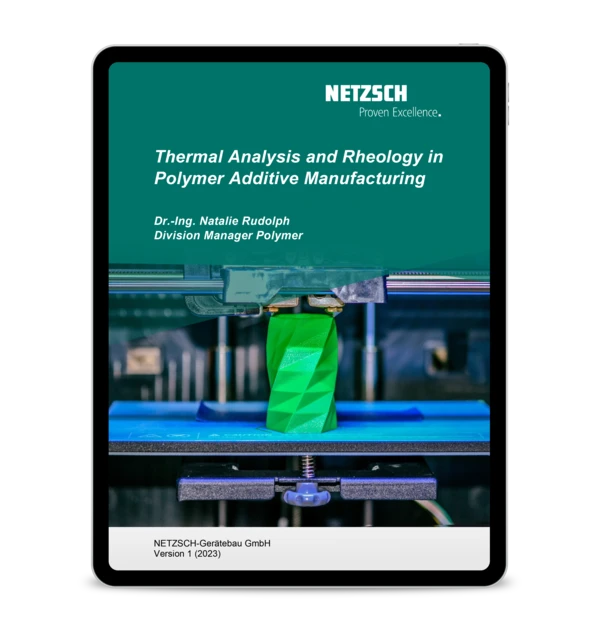
15.03.2021 by Milena Riedl
How Photo-DSC Advances Test Protocols of Liquid Samples for Additive Manufacturing
Photopolymers have gained increased importance in many industries. Digital Light Synthesis (DLS), an Additive Manufacturing Technology, is a prime example for the usage of photopolymers. Learn why the NETZSCH Photo-DSC is a proven method to optimize the Additive Manufacturing process.
For instance, they are used as standard materials for adhesives, paints and composites as well as varnishes on various substrates. New applications for the material include food packaging, biomedical implants and Additive Manufacturing (AM).
Digital Light Synthesis (DLS), an Additive Manufacturing Technology formerly known as Continuous Liquid Interface Production (CLIP), is a prime example for the usage of photopolymers in AM.
Learn more about DLS, also known as Continuous Liquid Interface Production (CLIP), in our video series Material Science in Additive Manufacturing. Click here to get to the video!
Photo-DSC is a proven method to analyze photopolymers
The NETZSCH Photo-DSC 204 F1 Phoenix® has been used in many previous studies and has proven “suitable to characterize photopolymers used in DLS due to its comparability to the actual process” [1].
The instrument has been used to track the thermal conversion as well as to identify optimal exposure times and exposure intensity for UV-reactive resins. It has been shown that the Photo-DSC is suitable to track the entire photopolymerization process of dual-Curing (Crosslinking Reactions)Literally translated, the term “crosslinking“ means “cross networking”. In the chemical context, it is used for reactions in which molecules are linked together by introducing covalent bonds and forming three-dimensional networks.curing resins in DLS and additionally detect thermal post-Curing (Crosslinking Reactions)Literally translated, the term “crosslinking“ means “cross networking”. In the chemical context, it is used for reactions in which molecules are linked together by introducing covalent bonds and forming three-dimensional networks.curing. Read the article here!
Objective for further research
The authors of the scientific paper at hand recognized that previous studies only mention the sample mass and film thickness for the investigated liquid resin samples. However, there is no information about the sample shape in the crucibles, which can significantly influence the measurements.
Furthermore, the use of an automatic sample changer (ASC) has not been considered so far. An ASC “can automatically place and remove the samples, which, for example, enables overnight measurements. The ASC is often used for DSC measurements with solid samples, but the effect of long times between sample preparation and start of the measurements (dwell times) has not yet been investigated for liquid photopolymers [1].”
For the study, the two-part resin systems RPU 70 and EPX 82 were used.
The full paper “Photo-DSC method for liquid samples used in vat photopolymerization” by Bachmann J. et al. can be accessed here!
Result No. 1: Speed up the photo-DSC test protocol
A new test protocol for measuring photopolymers with the photo-DSC has been evaluated. The authors of the paper found that “reducing the exposure segments from 4 x 2 min to 2 x 3 min has no significant effect on the photo-DSC measurement of RPU 70 – part A. The total time of the photo-DSC test protocol can thus be shortened from 42 min to 24 minutes while maintaining the same measurement accuracy” [1].
Result No. 2: Influence of temperature and oxygen on UV-reaction
It was found that “the influence of temperature on photopolymerization of RPU 70 is much greater than on EPX 82” [1]. Simultaneously, “both resins show a decrease in reaction heat with rising oxygen concentration” [1].
Result No. 3: How sample shape, sample mass and dwell time influence measurements
The authors of the paper found that “the 1.0 mg spread sample shape is the optimal sample preparation for process-close investigations like wavelength, light-intensity, exposure time and atmosphere” [1]. If one is interested in the effects of long dwell times, the 2.8-mg drop sample shape is optimal.
Result No. 4: How different crucibles and dwell time influence photo-DSC measurements
In earlier experiments, it became apparent “that mass loss due to the evaporation of reactive molecules plays a much greater role” than effects of O2–diffusion and ambient UV–radiation. Different kinds of crucible coverings by NETZSCH were used to identify if evaporation can be reduced.
Using SFI–crucibles (Al pan with an indentation for more consistent sample surface area) that are covered by 300 µl Al2O3–crucibles (removed shortly before the measurement) was found to generate the lowest mass loss, when using an automatic samples changer (ASC).
Photo-DSCs with automatic sample changer are key to investigate photopolymers
The study by Bachmann J. et al. showed that the NETZSCH Photo-DSC 204 F1 Phoenix® is a state-of-the-art instrument that allows for comprehensive analysis of photopolymers used in the DLS Additive Manufacturing technology.
The confirmed possibility to achieve reliable results when using an automatic sample changer (ASC) allows for overnight measurements.
Source [1] https://doi.org/10.1016/j.aca.2021.338268

FREE E-Book
Thermal Analysis and Rheology in Polymer Additive Manufacturing
Discover the secrets behind AM's game-changing capabilities! Our newly released ebook delves deep into the heart of AM, unveiling the power of reliable material characterization techniques, specifically thermal analysis and rheology.